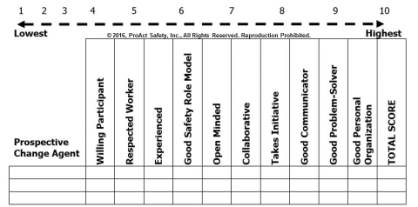Characteristics of Effective Safety Culture Change Agents
Often, employees who have been injured develop serious attitudes about safety and have great credibility when they speak about safety to others.
Who are the change agents in your organization? Who influences others to make improvements in performance without force? Cultures do not naturally resist all change. People change all the time, and so do the cultures they are a part of. It is not the change that is resisted; it is being changed by force.
Experience teaches that forced change is almost always temporary. When the force and the forcer of the change leaves, so does the change. Cultures change all the time when the benefit is identified and appreciated. Experience also teaches that culture change happens best from within and is usually led by a team of influential individuals from many different areas and levels.
More than 2,000 global safety performance and culture improvement consulting projects led ProAct Safety consultants to identify 10 characteristics of effective change agents. Use the following guidelines as you consider individuals to make up an effective and influential team for safety culture improvement. In STEPS to Safety Culture Excellence (2013, Mathis and Galloway), we referred to this as a Safety Excellence Team (SET).
The team collectively needs these characteristics, not each and every member of the team. Members of the team can have talents in various areas and not in others, as long as the whole team has enough of the desired characteristics to be able to function.
Willing Participant. Good committee members cannot be coerced into participation. It is not necessary that each committee member volunteer, but he or she must be willing to participate when invited. However, many good committee members have expressed a level of skepticism at first. Being skeptical is common and should not automatically eliminate a worker from consideration.
Respected Worker. Change agents must be taken seriously by different levels of the organization and their peers. Be careful not to mistake popularity for respect.
Experienced. Novices seldom have adequate knowledge of the site, the people, or the safety issues to be effective committee members. Don't necessarily select all "old timers," but avoid anyone who has not been on the job long enough to really know the ropes.
Safety Role Model. Change agents do not have to be incident free, but they need to be serious about safety. Often, employees who have been injured develop serious attitudes about safety and have great credibility when they speak about safety to others.
Open-Minded. Change agents need to be able to learn and manage new ways of doing things. Some people are overly opposed to anything new or different. Such people can seriously hold back progress if they are put in a position of leadership.
Collaborative. Change agents need to be good team players. They need to work together and be able to come to consensus. Those with reputations for stubbornness and not getting along with their peers should be eliminated from consideration.
Takes Initiative. Good change agents should be self-starters. They should have demonstrated initiative on work projects or extra assignments.
Good Communicator. Change agents should be able to effectively communicate with their peers and other levels within the organization. They do not need to be professional speakers but should be able to effectively express ideas.
Good Problem-Solver. Change agents will be given data and expected to identify and solve safety problems. Individuals with demonstrated ability to solve problems should be given strong consideration if they meet other criteria.
Personal Organization. Change agents will need to manage multiple roles and priorities. Individuals with the ability to get things done in an organized way often make good team members.
SELECTION SCORING CHART
Use the chart outlined in the figure below to compare prospective change agents and team members. On a scale of 1-10, with 1 being the lowest and 10 the highest, rate the prospective member on each of the characteristics. Total the score by adding the row.

Figure: Selecting Effective Safety Culture Change Agents
Safety is only one aspect of company or group culture. All companies have certain beliefs, behaviors, norms, knowledge levels, and stories specific to safety that already exist. To create clarity and provide common language, we call this their "safety culture," and every company already has one of varying degrees of maturity.
Who are the influencers in your organization specific to the aspects of safety within your culture? How are you leveraging them to evolve the culture from within? Who is on your culture-improvement teams, and what led to them being chosen? Was it because they had the right agreed-upon characteristics, or were they voluntold?
To receive a copy of the scoring chart to help you lead these selection decisions for improving your culture, contact the author at [email protected]m and mention Selecting Effective Safety Culture Change Agents Scoring Chart.
This article originally appeared in the September 2016 issue of Occupational Health & Safety.